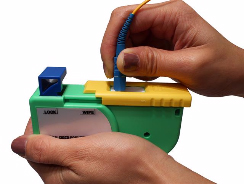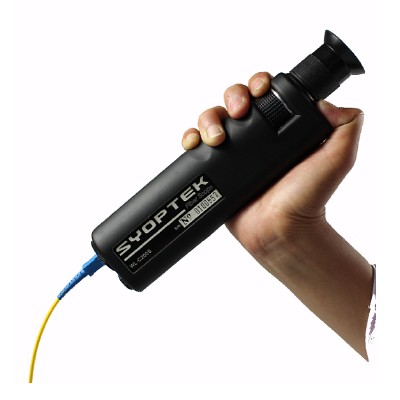Over the past decade, the use of fiber optics in the medical industry has steadily increased. From extensive medical
applications, including light therapy, arthroscopic surgery, x-ray imaging, ophthalmic lasers, and lab and clinical diagnostics, to simple communication processes, such as transmitting patient information, fiber optics help medical professionals conduct procedures that were previously not possible.
Maintenance of the connector endface is imperative for the fiber optic instrument to work correctly. It is an exacting job: the microscopic termini that create a connection must meet at an exact place, and the glass cores need to be perfectly aligned in order to have signal transmitted to and from the device. In addition, the termini endfaces must be completely clean of contaminants to ensure minimal signal loss. One of the most basic and important procedures for the maintenance of fiber optic systems is to clean the fiber optic termini.
Contamination Challenges
Like many medical devices, cleanliness is crucial to the performance of fiber optic instruments. Any contamination on the termini endface can cause failure of the component or the system as a whole. Even microscopic particles on the endfaces can cause a variety of problems for optical connections. One of the biggest challenges of contamination is that it cannot be seen with the naked eye, and one must typically use a specialized 200x or 400x inspection scope to determine the cleanliness of the endface. A close inspection of the connector is critical to identify that particles and residue are completely eliminated, thereby ensuring that connections work to their full potential.
A variety of serious, undesired outcomes could occur if a contaminated fiber optic connection is being used, from deteriorated performance levels to ruined instruments. A dirty fiber optic endface will significantly degrade signal transmission and can result in blocking the signal all together. Even if a particle is only situated on the ferrule or the edge of the endface, it can cause an air gap or misalignment in the termini between the cores. This can result in back reflections, instability in the laser system, signal attenuation or even a system shutdown. Another potential issue is a scratched surface as a result of dust particles trapped between two termini endfaces. What’s more is that some fiber optic instruments, such as those using high-power Class IV lasers, generate a significant amount of heat, which, when in contact with contaminants, can spark a violent reaction or fire.
One of the biggest challenges related to cleaning fiber optic termini is finding a process that works. Improvising a cleaning process will almost certainly lead to failure, as previously outlined. The best advice is to inspect, clean, and inspect again. Repeat this process until you are absolutely sure the instrument is clear of all contaminants. Spending the time to clean it right the first time saves time and money in the end.
Cleaning Methods 101
Materials used to clean the endfaces must be pristine; otherwise you could make it worse by adding contamination. It may be intuitive to wipe the endface on your gown or a cloth, but under a typical fiber optic inspection scope, those items carry a large variety of contaminants that could soil the connector. Even touching the termini with your finger will cause it to be significantly dirtied with skin oil. To avoid further contamination, make sure to use a product that has been specifically manufactured for cleaning fiber optics. Always wash your hands prior to using cleaning materials to minimize the transfer of skin oil onto the cleaning surfaces.
There are two primary methods available to properly clean fiber optic termini: a specialty wipe for male connectors and a swab for female connectors. Particulates, oils, and salts are the three basic types of contaminants found on the endfaces, all of which require their own cleaning methods. Particulates are solids that are held on the endface by a static attraction. The best way to clean these types of contaminants is by dissipating the static charge that both attracts and holds them in place, which can usually be done with a specialty cleaning fluid. Cleaning fluids are also used to dissolve oils found on the fiber. Salts, on the other hand, are not necessarily fully removed by cleaning fluids alone. While cleaning fluids may quickly rinse away the oils, they tend to leave salt remains behind in the form of a white residue that can be very difficult to remove. Mechanical action that a wipe or a swab provides is usually combined with a cleaning fluid to fully eliminate oil and salt left on the termini endface.
Buyer beware, it’s fair to say that some fiber optic cleaning products on the market can leave the endface dirtier than when you started. To avoid this situation, look for products that offer engineered solutions formulated to rid the termini endface of particulates, oils, and salts. Avoid using aqueous (water-based) cleaning solutions or pure isopropyl alcohol (IPA), as violent reactions could potentially occur. Aqueous products are slow to dry and can leave moisture on the endface. In cold ambient temperatures, the moisture may actually freeze on the endface and alignment sleeve. If the moisture is not completely removed before the fiber is connected in the sleeve, the laser-energized fiber will instantly vaporize the remaining liquid into a gas, causing an explosion through sudden expansion of the vapors. As with water-based cleaners, IPA may explode or catch on fire when left on a highly energized fiber endface. Adding insult to injury, IPA also frequently leaves a hazy film behind when it dries. What you should look for is a fast-drying, high-purity fluid engineered specifically for cleaning fiber optics.
High-purity cleaning fluids can and should be used with both wipe and swab applications. However, beware of presaturated cleaning materials. fiber optic presaturated wipes and fiber optic cleaning swabs often contain microscopic contaminants drawn from the plastic packaging, which will transfer to the endface during the cleaning process and result in further contamination problems. Instead, carefully apply a small amount of high-purity cleaning fluid on the corner of a dry wipe or the tip of the swab and then apply to the fiber optic termini. A well-engineered cleaning fluid will not only dissolve oils found on the endface, but will help to eliminate the electrostatic charge generated when the applicator is pulled out of its packaging. Be sure to not touch the area of the wipe or swab you will be using with your finger or your clothing. Should you touch this area or drop it on the ground, discard the wipe or swab and start over. Once the cleaning process is complete, discard the wipe or swab and inspect the endface to make sure all contaminants have been eliminated.
Bottom Line: Performance Critical Cleaning
As fiber optics usage continues to grow in the medical industry, it is imperative to clean the termini endfaces properly the first time around with the right products the proper way. The consequences of an unclean fiber optic can be detrimental to your business operations. Medical professionals can’t afford to have a blocked connection, a fire, or a complete system shutdown when there is a patient on the table. Use the correct cleaning solutions and closely inspect the endface to avoid these costly mistakes. Investing the time, energy and money into the cleaning process at the beginning will end up saving you in the end.
Jay Tourigny is vice president of operations at MicroCare Medical. He has 25+ years of industry experience and holds numerous U.S. patents for cleaning-related products that are used in medical, fiber optic, and precision cleaning applications. He holds a Bachelor of Science degree from Massachusetts College of Liberal Arts
Fiberopticcleanings.com stocks a variety of fiber optic cleaning supplies, from one click cleaner to fiber optic cleaner, from fiber optic cleaning wipes to fiber optic cleaning kit – everything you need for fiber optic cleaning jobs, BUY NOW and get FREE SHIPPING on most items!




